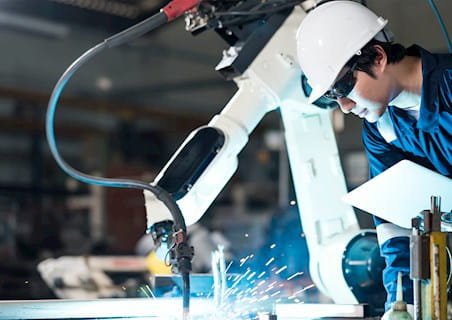Episode 22: The 5 Trends Shaping the Future of Tech
Casey Foss, Chief Commercial Officer at West Monroe
Q&A
Casey, what are the top three takeaways from this e-book given your vantage point as the Chief Commercial Officer at West Monroe?
- Learn to separate the fundamentals from the fads: Given the rapid pace of changing technology today, it is easy to get caught up in the latest buzz and hype. However, it’s essential to understand the challenges of modern business and apply the lens of what technology is here to stay vs. What might be gone tomorrow before jumping in. Companies need to pay attention, be agile, and listen as to never lose sight of the fundamentals of customer wants and needs.
- Get comfortable with taking risks: In the not-so-distant past, organizations at the top of the industry stayed at the top until they made a mistake. These days, however, no industry is safe from disruption. A company is at the top until another company innovates something new, and that’s why companies can never stop experimenting with new ways of reaching customers, new products and services and new digital technologies.
- Make bets on the present, but do not forget about the future: While it may feel like we’re living in uncertainty, uncertainty is the new status quo, and it’s time to get comfortable in this space. This is where we see leaders get past the paralysis of the present and make near-term decisions and find one or two things they can invest in, try, or change on a dime if they’re not working.
Let’s dive into the e-book. The first trend is a rapidly changing and increasingly distributed innovation landscape. Tell us more about what that means in the context of tech trends. What is it, why does it matter, and what should businesses do about it?
As I think about the rapidly changing and increasingly distributed innovation landscape, industries can no longer stay in their lane. Rather than looking at just your industry, companies should look at and learn from the best of the best in all industries.
From an action-oriented approach, a macro-level change in the B2C industry is forcing change in industries that are more B2B that previously didn’t have to look into the B2C world. For instance, Amazon has changed customers' expectations with how people engage with health care providers, and now people expect a digital to physical experience when doing heath care related things like doctor visits, lab reports, surveys and questionnaires, and results.

The second trend is the proof positive need for methodical end-to-end due diligence in M&A. How are we seeing this show up in the market today?
The proliferation of data has changed the game because now we can use all this data to make faster and better decisions without the human blinder component. This approach should now be used across all industries, including M&A. Currently, there’s an opportunity to acquire strategically not only in PE but overall. I think it’s about a balance between not buying into the hype but also not just considering the risk; just because you have cash on hand doesn't mean you have to spend it, and it’s also crucial to find the right fit. I think focusing on this type of insight is going to be key in the current market environment. Overall, investments and capitalizing on digital advantages in my opinion will be the driver of growth and return on investments in the future.
The third trend is about the symbiotic relationship between technology and customer trust. This is a big one because trust is so important in the client company relationship and directly impacts the bottom line. Is there an example that comes to mind? What is the action that companies should take?
One example that comes to mind is Southwest Airlines, and the holiday meltdown last year around the holidays. Southwest had spent a lot of time on the app and the interface, but not so much time on their back-end technology. As a result, they lost over a billion dollars from lost revenue from canceled flights, refunds and reimbursements to passengers. Now, in 2023, Southwest has committed to spending $1.3 billion on IT maintenance and upgrades as a follow-up to what happened in December of 2022. However, this could have been avoided had they been investing in their back-end technology all along versus focusing only on what they felt the customer could see and feel.
First and foremost, ensure that you're investing in the right backend tech to keep operations running smoothly, even if it's not the shiny thing that will get noticed externally.
If we're going to be on the forefront of leading this energy transformation and energy transition, we need to be maximizing our use of technology and engagement with our customers.
”
And in the Southwest case, getting on the plane that takes off and lands on time and being able to actually get to their destination is more important than the app itself.
The fourth trend is the business risks and opportunities of today’s workforce. This is top of mind for so many people hearing about or experiencing layoffs across the country, new workforce trends and ways of working. Can you share what this trend is, why it matters and what we should be doing as a result?
Employers of top tech talent are no longer solely in the technology sector. They're expanding into organizations in the banking and financial services sector, the consulting space, health care, retail, and even defense. The recent tech layoffs have injected new talent into the market, which could tip the scale toward the non-tech industries even more. In fact, more than half of the displaced tech workers have found jobs outside of that sector in 2023, which is a big deal. Due to the amount of technology or digital talent in the market, which wasn't previously available, companies are now starting to hire this talent, changing the dynamics of corporate America. This is important because according to IDC, by 2026, enterprises that don't effectively address their organization's talent and digital skills gap will constrain their revenue growth by 20%. So, what can companies do? I would tell industry companies as they hire this tech talent, they should look outside their industries to leverage the tech skills to further digitize their companies. Companies should also lean into this talent to close their digital skill gap of the existing employee base.
Our fifth and final trend is the rise of generative AI. This was the last point of our piece because it's a thread that runs through it all. Can you share why it matters and what actions people should be taking?
As organizations define and refine their AI goals and strategies, it's crucial to remember that AI is not and never will be a complete solution on its own. It's a powerful enabler for digital businesses that can augment and improve the output and results of their people. It's another tool to be used to drive greater value from the employees of an organization, change how we serve customers and run operations, but it has to work in uniform with the people. We believe that humans are the interface between generative AI and the world, which means you must hire the right employees who can build, instruct, and redesign models when needed. Bottom line is that if you don’t have enough internal digital first skills, such as data literacy, you're not going to be able to take advantage of generative AI. I think companies need to build up their digital maturity, capitalize on digital investments, and ensure their employees have the right skills. At the end of the day, while we have all this technology, it’s the human component that truly takes it all to the next level.
Are there any final takeaways that you'd like to share with our listeners?
I’d like to leave the listeners with two things:
- Changing mindsets continues to be extremely important because the future isn’t a theoretical concept anymore. Innovators and game changers are building the future every day. Companies should take time to design and invest in their future and make choices carefully along the way.
- Maintain a balance between current and future challenges. While it might be difficult to keep one foot in the present and one in the future, that balance is what’s required as we think about the long-term implications of the tech trends impacting the business we’re serving today.
Related Content
This is Digital
West Monroe's team of experts and guests pull back the curtain on how to build digital throughout an organization. Through real-world examples, you will learn how to spot digital transformation in real life, and how to make small decisions every day that make a big impact on growth.










